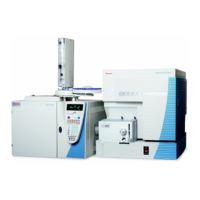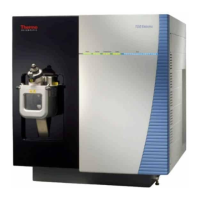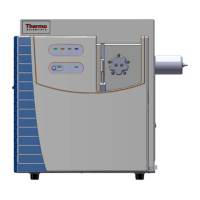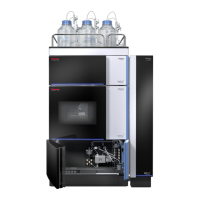2
Functional Description
Mass Spectrometer
Thermo Scientific TSQ Series Hardware Manual 27
Source CID can also be accomplished by increasing the dc voltage offset between the
skimmer, which is at ground potential, and the rest of the mass spectrometer beginning with
Q00. You use the Source CID parameter in the Tune Master software to adjust this potential.
The lens L0 is a metal cylinder with a small hole in one end through which the ion beam can
pass. A potential of between 0 and ±3 V (negative for positive ions and positive for negative
ions) is applied to lens L0 to aid in ion transmission. Lens L0 also acts as a vacuum baffle
between the Q00 and Q0 ion optics chambers.
Q0 Ion Optics
The Q0 ion optics transmits ions from the Q00 ion optics to the mass analyzer. The Q0 ion
optics includes the Q0 quadrupole and lenses L11 and L12.
The Q0 quadrupole is a square array of square-profile rods that act as an ion transmission
device. See Figure 21. An rf voltage applied to the rods gives rise to an electric field that guides
the ions along the axis of the quadrupole. The Q0 offset voltage increases the translational
kinetic energy of ions emerging from Q00.
Figure 21. Q0 quadrupole
The Q0 offset voltage can also be used to fragment ions. In ion source collision-induced
dissociation, the offset voltage (typically –30 V to +30 V) imparts enough kinetic energy to
the ions so that, when they collide with solvent or air molecules, the ions dissociate to form
product ions. The translational kinetic energy imparted to the ions determines the degree of
dissociation. At low energies, adduct ions convert to sample ions by collision-induced
dissociation without fragmenting. At higher energies, molecular ions can fragment and
thereby enable primitive MS/MS/MS analysis.
The L11 and L12 lenses are metal disks with a circular hole in the center through which the
ion beam can pass. See Figure 22. Together they act as a two-element cone lens. An electrical
potential applied to the lens accelerates (or decelerates) ions as they approach the lens to focus
the ion beam as it passes through the lens. The value ranges between 0 and ±300 V. Lenses
L11 and L12 also act as a vacuum baffle between the Q0 ion optics chamber and the mass
analyzer chamber.

